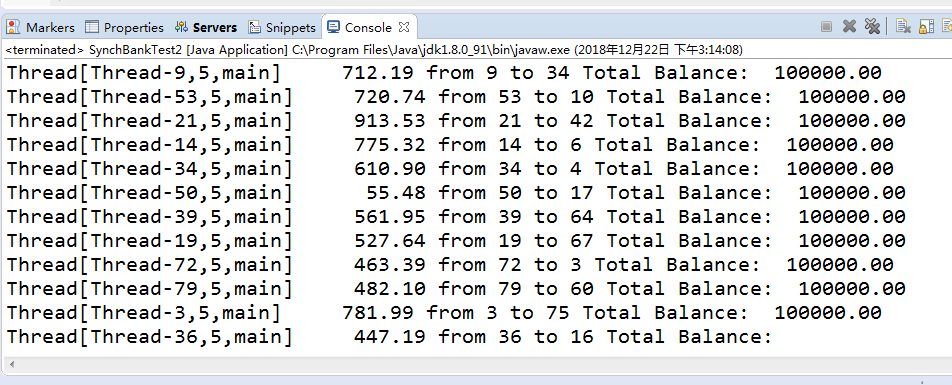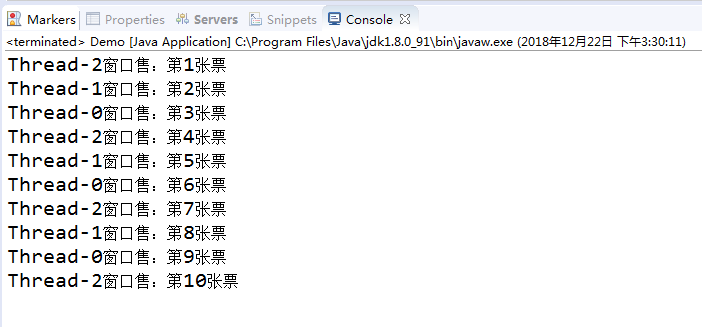第一部分:理论基础
线程的同步
多线程并发运行不确定性问题解决方案:引入线 程同步机制,使得另一线程要使用该方法,就只 能等待。
在Java中解决多线程同步问题的方法有两种: - Java SE 5.0中引入ReentrantLock类。 - 在共享内存的类方法前加synchronized修饰符。
解决方案一:锁对象与条件对象
用ReentrantLock保护代码块的基本结构如下: myLock.lock(); try { critical section } finally{ myLock.unlock(); }
有关锁对象和条件对象的关键要点:
锁用来保护代码片段,保证任何时刻只能有一个线程执行被保护的代码。
锁管理试图进入被保护代码段的线程。
锁可拥有一个或多个相关条件对象。
每个条件对象管理那些已经进入被保护的代码段但还不能运行的线程。
解决方案二: synchronized关键字
synchronized关键字作用:
➢某个类内方法用synchronized 修饰后,该方法被称为同步方法;
➢只要某个线程正在访问同步方法,其他线程欲要访问同步方法就被阻塞,直至线程从同步方法返回前唤醒被阻塞线程,其他线程方可能进入同步方法。
第二:实验部分
实验目的与要求:
(1) 掌握线程同步的概念及实现技术;
(2) 线程综合编程练习
2、实验内容和步骤
实验1:测试程序并进行代码注释。
测试程序1:
l 在Elipse环境下调试教材651页程序14-7,结合程序运行结果理解程序;
l 掌握利用锁对象和条件对象实现的多线程同步技术。
package synch;
import java.util.*;
import java.util.concurrent.locks.*;
/**
* A bank with a number of bank accounts that uses locks for serializing access.
* @version 1.30 2004-08-01
* @author Cay Horstmann
*/
public class Bank
{
private final double[] accounts;
private Lock bankLock;
private Condition sufficientFunds;
/**
* Constructs the bank.
* @param n the number of accounts
* @param initialBalance the initial balance for each account
*/
public Bank(int n, double initialBalance)
{
accounts = new double[n];
Arrays.fill(accounts, initialBalance);
bankLock = new ReentrantLock();
sufficientFunds = bankLock.newCondition();//在等待条件前,锁必须由当前线程保持。
}
/**
* Transfers money from one account to another.
* @param from the account to transfer from
* @param to the account to transfer to
* @param amount the amount to transfer
*/
public void transfer(int from, int to, double amount) throws InterruptedException
{
bankLock.lock();//加锁
try
{//锁对象引用条件对象
while (accounts[from] < amount)
sufficientFunds.await();//造成当前线程在接到信号或被中断之前一直处于等待状态。
System.out.print(Thread.currentThread());
accounts[from] -= amount;
System.out.printf(" %10.2f from %d to %d", amount, from, to);
accounts[to] += amount;
System.out.printf(" Total Balance: %10.2f%n", getTotalBalance());
sufficientFunds.signalAll();//如果所有的线程都在等待此条件,则唤醒所有线程
}
finally
{
bankLock.unlock();//解锁。
}
}
/**
* Gets the sum of all account balances.
* @return the total balance
*/
public double getTotalBalance()
{
bankLock.lock();
try
{
double sum = 0;
for (double a : accounts)
sum += a;
return sum;
}
finally
{
bankLock.unlock();
}
}
/**
* Gets the number of accounts in the bank.
* @return the number of accounts
*/
public int size()
{
return accounts.length;
}
}
package synch;
/**
* This program shows how multiple threads can safely access a data structure.
* @version 1.31 2015-06-21
* @author Cay Horstmann
*/
public class SynchBankTest
{
public static final int NACCOUNTS = 100;
public static final double INITIAL_BALANCE = 1000;
public static final double MAX_AMOUNT = 1000;
public static final int DELAY = 10;
public static void main(String[] args)
{
Bank bank = new Bank(NACCOUNTS, INITIAL_BALANCE);
for (int i = 0; i < NACCOUNTS; i++)
{
int fromAccount = i;
Runnable r = () -> {
try
{
while (true)
{
int toAccount = (int) (bank.size() * Math.random());
double amount = MAX_AMOUNT * Math.random();
bank.transfer(fromAccount, toAccount, amount);
Thread.sleep((int) (DELAY * Math.random()));//在指定的毫秒数内让当前正在执行的线程休眠
}
}
catch (InterruptedException e)
{
}
};
Thread t = new Thread(r);
t.start();//使线程开始执行
}
}
}
运行结果:

测试程序2:
l 在Elipse环境下调试教材655页程序14-8,结合程序运行结果理解程序;
l 掌握synchronized在多线程同步中的应用。
package synch2;
import java.util.*;
/**
* A bank with a number of bank accounts that uses synchronization primitives.
* @version 1.30 2004-08-01
* @author Cay Horstmann
*/
public class Bank
{
private final double[] accounts;
/**
* Constructs the bank.
* @param n the number of accounts
* @param initialBalance the initial balance for each account
*/
public Bank(int n, double initialBalance)
{
accounts = new double[n];
Arrays.fill(accounts, initialBalance);
}
/**
* Transfers money from one account to another.
* @param from the account to transfer from
* @param to the account to transfer to
* @param amount the amount to transfer
*/
public synchronized void transfer(int from, int to, double amount) throws InterruptedException
{
while (accounts[from] < amount)
wait();//添加一个线程到等待一个集中
System.out.print(Thread.currentThread());
accounts[from] -= amount;
System.out.printf(" %10.2f from %d to %d", amount, from, to);
accounts[to] += amount;
System.out.printf(" Total Balance: %10.2f%n", getTotalBalance());
notifyAll();//解除当前线程的阻塞状态
}
/**
* Gets the sum of all account balances.
* @return the total balance
*/
public synchronized double getTotalBalance()
{
double sum = 0;
for (double a : accounts)
sum += a;
return sum;
}
/**
* Gets the number of accounts in the bank.
* @return the number of accounts
*/
public int size()
{
return accounts.length;
}
}
package synch2;
/**
* This program shows how multiple threads can safely access a data structure,
* using synchronized methods.
* @version 1.31 2015-06-21
* @author Cay Horstmann
*/
public class SynchBankTest2
{
public static final int NACCOUNTS = 100;
public static final double INITIAL_BALANCE = 1000;
public static final double MAX_AMOUNT = 1000;
public static final int DELAY = 10;
public static void main(String[] args)
{
Bank bank = new Bank(NACCOUNTS, INITIAL_BALANCE);
for (int i = 0; i < NACCOUNTS; i++)
{
int fromAccount = i;//内部类的使用
Runnable r = () -> {
try
{
while (true)
{
int toAccount = (int) (bank.size() * Math.random());
double amount = MAX_AMOUNT * Math.random();
bank.transfer(fromAccount, toAccount, amount);
Thread.sleep((int) (DELAY * Math.random()));
}
}
catch (InterruptedException e)//抛出异常
{
}
};
Thread t = new Thread(r);
t.start();
}
}
}
运行结果;

测试程序3:
l 在Elipse环境下运行以下程序,结合程序运行结果分析程序存在问题;
l 尝试解决程序中存在问题。
| class Cbank { private static int s=2000; public static void sub(int m) { int temp=s; temp=temp-m; try { Thread.sleep((int)(1000*Math.random())); } catch (InterruptedException e) { } s=temp; System.out.println("s="+s); } } class Customer extends Thread { public void run() { for( int i=1; i<=4; i++) Cbank.sub(100); } } public class Thread3 { public static void main(String args[]) { Customer customer1 = new Customer(); Customer customer2 = new Customer(); customer1.start(); customer2.start(); } } |
package demo1;
class Cbank
{
private static int s=2000;
public static void sub(int m)
{
int temp=s;
temp=temp-m;
try {
Thread.sleep((int)(1000*Math.random()));
}
catch (InterruptedException e) { }
s=temp;
System.out.println("s="+s);
}
}
class Customer extends Thread
{
public void run()
{
for( int i=1; i<=4; i++)
Cbank.sub(100);
}
}
public class Thread3
{
public static void main(String args[])
{
Customer customer1 = new Customer();
Customer customer2 = new Customer();
customer1.start();
customer2.start();
}
}
运行结果:

实验2 编程练习
利用多线程及同步方法,编写一个程序模拟火车票售票系统,共3个窗口,卖10张票,程序输出结果类似(程序输出不唯一,可以是其他类似结果)。
Thread-0窗口售:第1张票
Thread-0窗口售:第2张票
Thread-1窗口售:第3张票
Thread-2窗口售:第4张票
Thread-2窗口售:第5张票
Thread-1窗口售:第6张票
Thread-0窗口售:第7张票
Thread-2窗口售:第8张票
Thread-1窗口售:第9张票
Thread-0窗口售:第10张票
public class Demo {
public static void main(String args[]) {
Mythread mythread = new Mythread();
Thread t1=new Thread(mythread);
Thread t2=new Thread(mythread);
Thread t3=new Thread(mythread);
t1.start();
t2.start();
t3.start();
}
}
class Mythread implements Runnable{
int t=1;
boolean flag=true;
public void run() {
while (flag) {
try {
Thread.sleep(500);
}
catch(InterruptedException e)
{
e.printStackTrace();
}
synchronized(this) {
if(t<=10) {
System.out.println(Thread.currentThread().getName()+"窗口售:第"+t+"张票");
t++;
}
if(t>10) {
flag=false;
}
}
}
}
}
运行结果:

实验总结:本周是学习的内容是同步线程,解决多线程同步问题的两种方案,分别是锁对象与条件对象引用和 synchronized关键字。在实验课上收获了当注释调代码sufficientFunds.await();会出现死锁状态等知识,感受颇多。注意点有:线程如果用完同步方法,应当执行notifyAll()方 法通知所有由于使用这个同步方法而处于等待的 线程结束等待。线程如果用完同步方法,应当执行notifyAll()方 法通知所有由于使用这个同步方法而处于等待的 线程结束等待。以后会坚持学习Java。